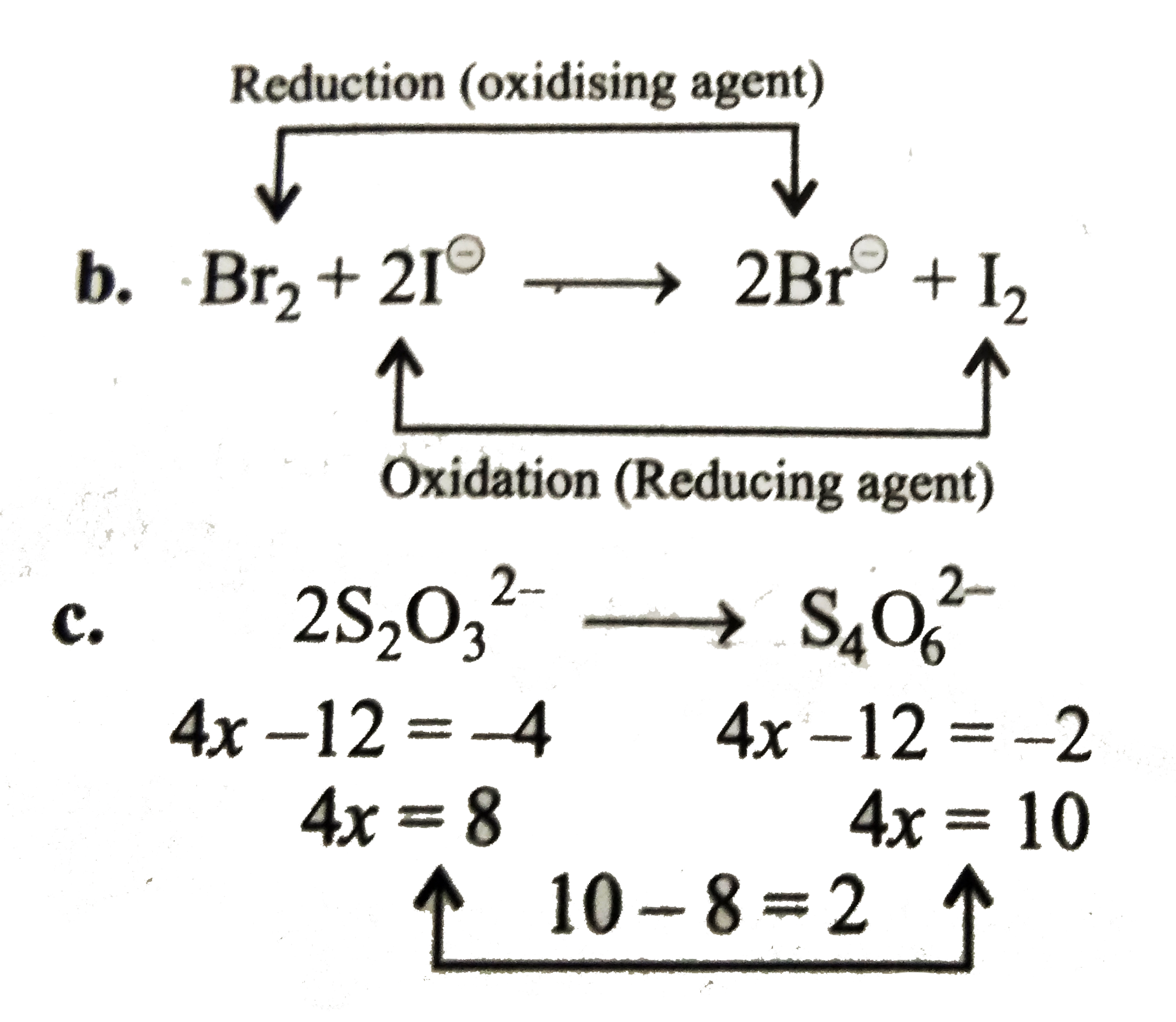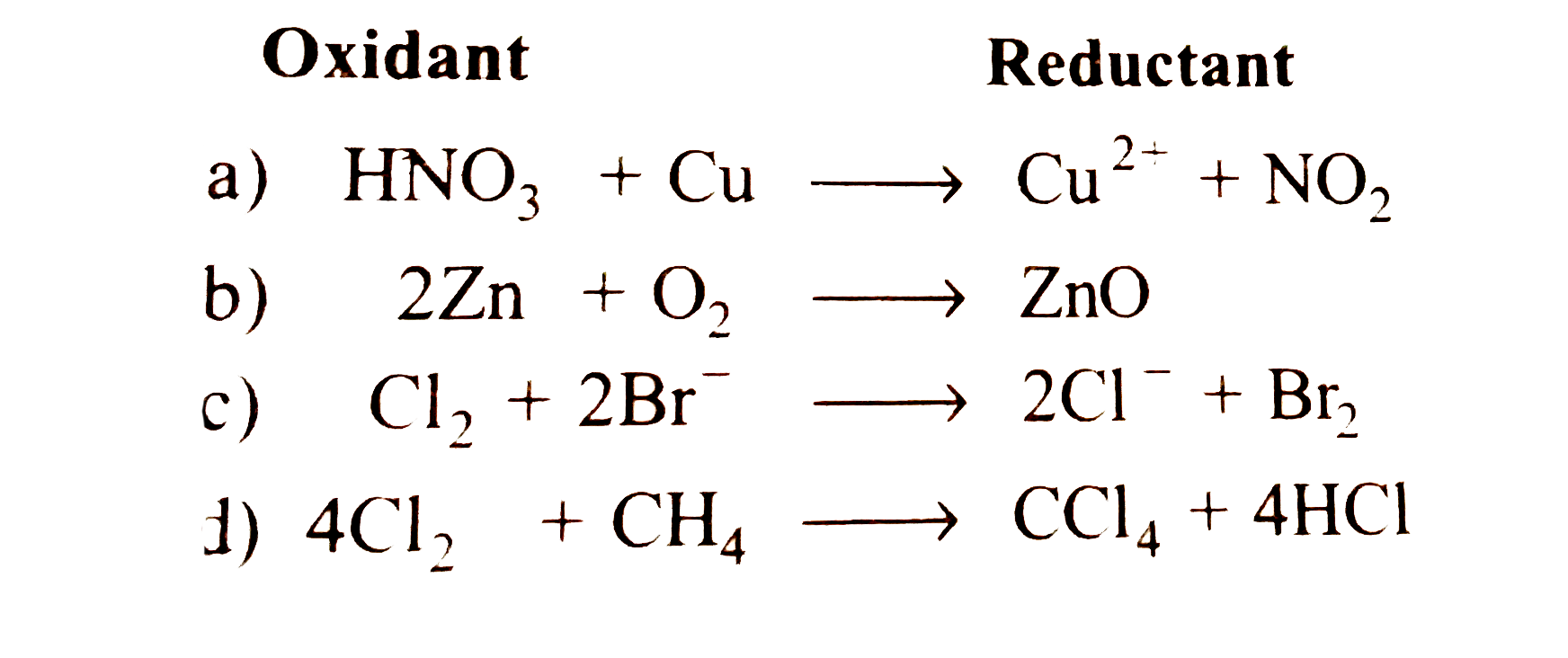Oxidation reaction involves loss of electrons, and reduction reaction involves gain of electrons. The reaction in which a species disproportinates into two oxidation states ( lower and higher) is called disproportionation reaction.
Which of the following statements is wrong?
Acidified KMnO4 solutions decolourises on the addition of sodium oxalate.
In the reaction between Br2 and CsI,Br2 is an oxidising agent and CsI is a reducing agent.
In the reaction 2K2SO3+I2→2KI+K2S4O6, the change in the oxidation number of S is 0.5.
C has the same oxidation number in both CH4 and CO2
The correct Answer is:D
a. The purple colour of KMnO4 is decolourised due ot the reduction of MnOө4 to Mn2+ and C2O2−4 is oxidised to CO2 in acidic medium.
2MnOө4+16H⊕+5C2O2−4→2Mn2++10CO2+8H2O
b. 
c. C––H4:x+4=0,x=−4
C––O2:x−4=0,x=4
Topper's Solved these Questions
- REDOX REACTIONSBOOK - CENGAGE CHEMISTRYCHAPTER - REDOX REACTIONSEXERCISE - Exercises (Multiple Correct)
32 Videos
- REDOX REACTIONSBOOK - CENGAGE CHEMISTRYCHAPTER - REDOX REACTIONSEXERCISE - Exercises (Single Correct)
91 Videos
- REDOX REACTIONSBOOK - CENGAGE CHEMISTRYCHAPTER - REDOX REACTIONSEXERCISE - Exercise
29 Videos
- PURIFICATION OF ORGANIC COMPOUNDS AND QUALITATIVE AND QUANTITATIVE ANALYSISBOOK - CENGAGE CHEMISTRYCHAPTER - PURIFICATION OF ORGANIC COMPOUNDS AND QUALITATIVE AND QUANTITATIVE ANALYSISEXERCISE - Assertion Reasoning Type
5 Videos
- S-BLOCK GROUP 1 - ALKALI METALSBOOK - CENGAGE CHEMISTRYCHAPTER - S-BLOCK GROUP 1 - ALKALI METALSEXERCISE - Archives Subjective
8 Videos
Similar Questions
Knowledge Check
Oxidation reaction involves loss of electrons, and reduction reaction involves gain of electrons. The reaction in which a species disproportinates into two oxidation states ( lower and higher) is called disproportionation reaction.
Which of the following statements is correct?AAn element in the lowest oxidation state acts only as a reducing agent.BAn element in the highest oxidation state acts only as a reducing agent.CThe oxidation number of V is Rb4K(HV10O28)is+4.DThe oxidation number and valency of Hg in calomel is +1A reduction reaction involves
Aaddition of oxygenBaddition of nitrogenCaddition of hydrogenDNone of the aboveOxidation reaction involves loss of electrons, and reduction reaction involves gain of electrons. The reaction in which a species disproportinates into two oxidation states ( lower and higher) is called disproportionation reaction.
Which of the following is not a dispropotional reaction?AөOH+Br2→Brө+BrOө3BCu2O+2H⊕→Cu+Cu2++H2OC(CN)ө→CO2−3+NOө3D(CN)2+2өOH→CNө+CNOө+H2O
Oxidation and reduction process involves the transaction of electrons. Loss of electrons is oxidation and the gain of electrons is reduction. It is thus obvious that in a redox reaction, the oxidant is reduced by accepting the electrons and the reductant is oxidised by losing electrons. The reactions in which a species disproportionates into two oxidation states (lower and higher) are called disproportionation reactions. In electrochemical cells, redox reaction is involved, i.e., oxidation takes place at anode and reduction at cathode.
Which of the following reactions is/are correctly indicated?

View SolutionOxidation and reduction process involves the transaction of electrons. Loss of electrons is oxidation and the gain of electrons is reduction. It is thus obvious that in a redox reaction, the oxidant is reduced by accepting the electrons and the reductant is oxidised by losing electrons. The reactions in which a species disproportionates into two oxidation states (lower and higher) are called disproportionation reactions. In electrochemical cells, redox reaction is involved, i.e., oxidation takes place at anode and reduction at cathode.
Select the correct statement:
View SolutionOxidation and reduction process involves the transaction of electrons. Loss of electrons is oxidation and the gain of electrons is reduction. It is thus obvious that in a redox reaction, the oxidant is reduced by accepting the electrons and the reductant is oxidised by losing electrons. The reactions in which a species disproportionates into two oxidation states (lower and higher) are called disproportionation reactions. In electrochemical cells, redox reaction is involved, i.e., oxidation takes place at anode and reduction at cathode.
The reaction Cl2→Cl−+ClO−3 is:
View SolutionOxidation and reduction process involves the transaction of electrons. Loss of electrons is oxidation and the gain of electrons is reduction. It is thus obvious that in a redox reaction, the oxidant is reduced by accepting the electrons and the reductant is oxidised by losing electrons. The reactions in which a species disproportionates into two oxidation states (lower and higher) are called disproportionation reactions. In electrochemical cells, redox reaction is involved, i.e., oxidation takes place at anode and reduction at cathode.
Detennine the change in oxidation number of sulphur in H2SandSO2 respectively in the following reaction:
2H2S+SO2→2H2O+3S
View SolutionOxidation and reduction process involves the transaction of electrons. Loss of electrons is oxidation and the gain of electrons is reduction. It is thus obvious that in a redox reaction, the oxidant is reduced by accepting the electrons and the reductant is oxidised by losing electrons. The reactions in which a species disproportionates into two oxidation states (lower and higher) are called disproportionation reactions. In electrochemical cells, redox reaction is involved, i.e., oxidation takes place at anode and reduction at cathode.
In the reaction:
I2+2S2O2−3→2I−+S4O2−6
View Solution
